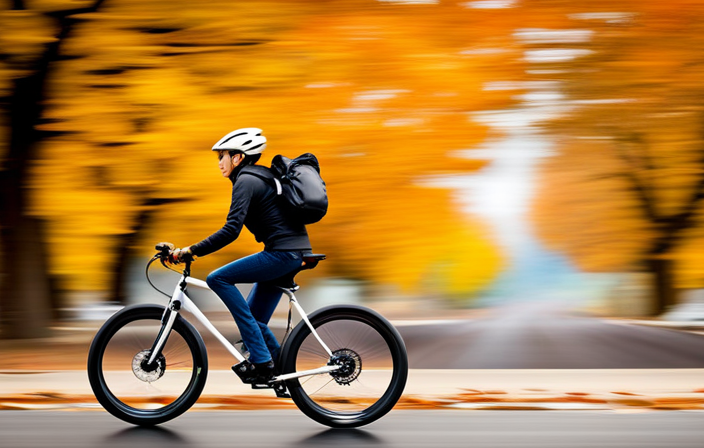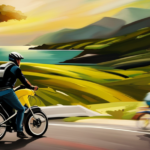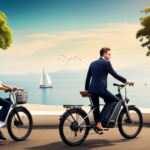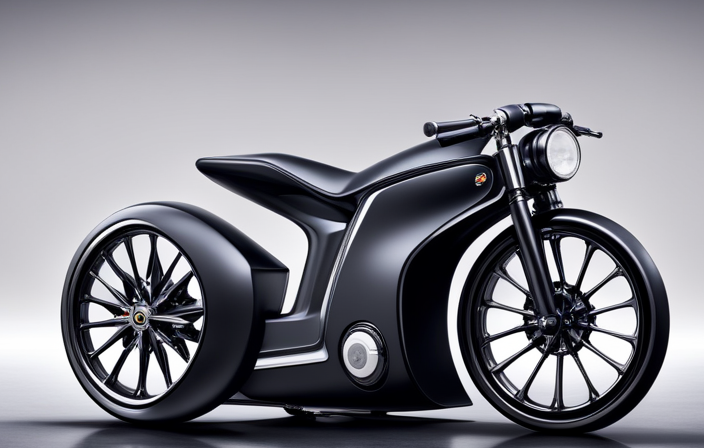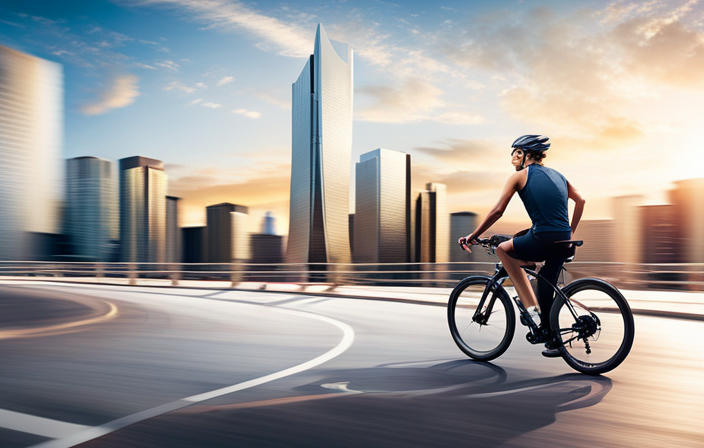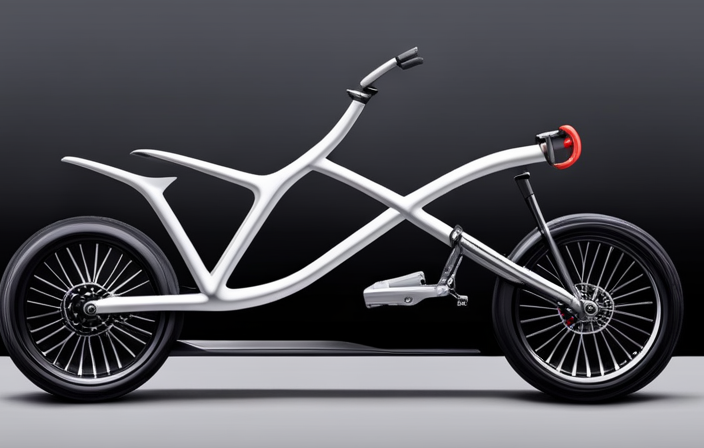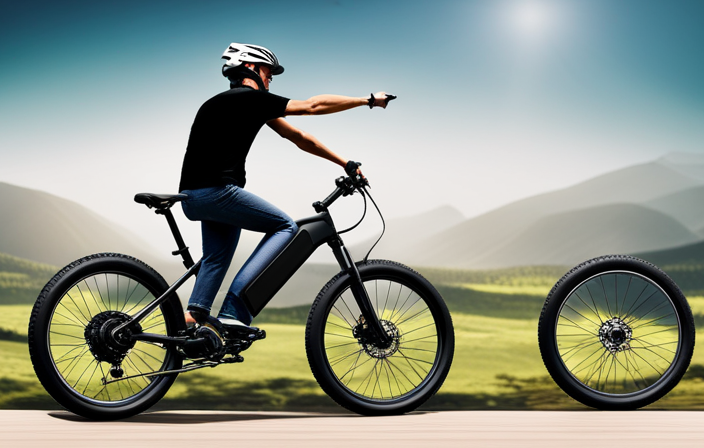Did you know that electric bikes can reach speeds of up to 28 miles per hour? That’s right, with the help of a motor, these bikes can take you places faster than ever before.
In this article, I will guide you through the world of electric bike speed limits, the different types of electric bikes, and the factors that can affect their speed.
We’ll also discuss how to increase your electric bike’s speed and important safety considerations.
So, if you’re ready to embrace the thrill of riding fast on an electric bike, let’s dive in!
Key Takeaways
- The speed of an electric bike can be increased by upgrading the motor and battery, with higher power options resulting in greater speed increases.
- Improving aerodynamics by choosing a sleek design, maintaining a low riding position, and adding aerodynamic accessories can also contribute to increased speed.
- Regularly checking and maintaining optimal tire pressure is important, as underinflated tires increase rolling resistance while overinflated tires decrease traction.
- When riding at higher speeds, it is crucial to prioritize safety by wearing a helmet, using proper hand signals, maintaining balance, and being aware of surroundings and potential obstacles.
Understanding Electric Bike Speed Limits
To understand electric bike speed limits, you need to know how fast you can go on an electric bike. Electric bikes have gained popularity in recent years due to their ability to provide a fun and efficient mode of transportation.
When it comes to speed, electric bikes can go quite fast, although the exact limit varies depending on the country and the type of electric bike. In some countries, the speed limit for electric bikes is set at 20 mph, while in others it can go up to 28 mph. However, it’s important to note that these are general speed limits and there are electric bike speed records that have reached even higher speeds.
Now that we understand the speed limits, let’s delve into the different types of electric bikes.
The Different Types of Electric Bikes
If you’re considering an e-bike, there are various types available for you to choose from. Understanding e-bike classifications is crucial in making an informed decision.
The three main types are pedal-assist, throttle-powered, and speed pedelecs. Pedal-assist e-bikes provide assistance only when you pedal, making them ideal for those who want to maintain an active lifestyle.
Throttle-powered e-bikes, on the other hand, allow you to control the speed with a twist or push of a button, providing a more effortless riding experience.
Speed pedelecs, also known as Class 3 e-bikes, can reach speeds of up to 28 miles per hour, making them suitable for commuting over longer distances.
Some popular electric bike brands known for their quality and performance include Rad Power Bikes, Trek, and Specialized.
Now, let’s delve into the legal speed limits for electric bikes.
Legal Speed Limits for Electric Bikes
When it comes to riding electric bikes, it’s important to be aware of the local regulations and laws in your area. Different regions may have varying rules in place regarding the use of electric bikes on public roads and bike paths.
These regulations can cover a range of factors, including speed limit restrictions that dictate how fast you can go on your electric bike.
Local Regulations and Laws
You should familiarize yourself with the local regulations and laws regarding electric bikes. Understanding speed restrictions and the legal consequences of not adhering to them is crucial.
In many areas, electric bikes are classified as bicycles and are subject to the same speed limits as traditional bicycles. This means that you may not be allowed to exceed a certain speed, typically around 20 mph.
However, it’s important to note that these regulations can vary from place to place, so it’s essential to research and understand the specific rules in your area. Failure to comply with these speed restrictions can result in fines or other legal consequences.
With this knowledge, we can now delve into the next section, which focuses on the speed limit restrictions for electric bikes.
Speed Limit Restrictions
It’s important to be aware of the speed limit restrictions for electric bikes in your area. Not only is it a matter of safety, but it also ensures that you stay within the legal boundaries.
When it comes to electric bike speed, accuracy is key. Many electric bikes come equipped with a speedometer, but it’s important to remember that their accuracy may vary. To ensure you are not breaking any speed limits, it’s crucial to regularly check the accuracy of your speedometer and compare it with a reliable source.
Additionally, speed limit enforcement for electric bikes can vary depending on local regulations. Some areas may have specific speed limits for electric bikes, while others may apply the same limits as regular bicycles. Understanding and respecting these restrictions is essential for responsible riding.
Now, let’s explore the factors that affect electric bike speed.
Factors That Affect Electric Bike Speed
One of the factors that can affect the speed of an electric bike is the weight of the rider. The heavier the rider, the more strain it puts on the motor and the battery. This can result in slower speeds and reduced battery life. To maximize performance, it’s important to consider the weight of both the rider and any additional cargo.
Understanding speed limitations and optimizing battery performance are key to getting the most out of your electric bike. In addition to weight, maintaining proper tire pressure and ensuring the bike is properly lubricated can also contribute to better speed and battery efficiency.
By paying attention to these factors, you can enjoy a smoother and faster ride on your electric bike.
When it comes to the typical speed range for electric bikes, there are several factors to consider.
Typical Speed Range for Electric Bikes
To determine the typical speed range of an electric bike, you should consider various factors. One important tool for measuring speed is the electric bike speedometer. This handy device allows you to keep track of your speed in real-time, giving you a clear indication of how fast you’re going.
Additionally, you can also look at speed records set by other electric bike riders. These records can give you an idea of what is possible in terms of speed. Typically, electric bikes have a speed range of around 20 to 28 miles per hour, depending on factors such as the motor power, battery capacity, and terrain. However, it’s essential to note that some electric bikes can reach even higher speeds.
Now, let’s explore how to increase your electric bike’s speed further.
How to Increase Your Electric Bike’s Speed
If you’re looking to increase the speed of your electric bike, there are a few key points to consider.
First, upgrading the motor and battery can make a significant difference in performance. By opting for a more powerful motor and a higher capacity battery, you’ll be able to reach higher speeds and maintain them for longer periods of time.
Additionally, improving the aerodynamics of your electric bike, such as using streamlined fairings or reducing wind resistance, can help you cut through the air more efficiently and increase your overall speed.
Lastly, don’t overlook the importance of maintaining optimal tire pressure. By keeping your tires properly inflated, you’ll reduce rolling resistance and maximize your bike’s speed potential.
Upgrading the Motor and Battery
Upgrading the motor and battery can significantly increase the speed of an electric bike. By investing in a motor upgrade, you can enjoy a more powerful and efficient ride. A higher wattage motor will provide more torque and speed, allowing you to tackle steep inclines and reach higher top speeds with ease. Similarly, a battery upgrade can extend your bike’s range and provide more power to the motor, resulting in increased speed and performance. To help you visualize the impact of these upgrades, here’s a comparison of different motor and battery options:
| Motor Upgrade | Battery Upgrade | Speed Increase |
|---|---|---|
| 500W | 36V 10Ah | 15 mph |
| 750W | 48V 14Ah | 20 mph |
| 1000W | 52V 17.5Ah | 25 mph |
With the right motor and battery upgrade, you can transform your electric bike into a high-speed machine. Now, let’s explore another important aspect of increasing your bike’s speed: improving aerodynamics.
Improving Aerodynamics
Now let’s focus on how you can enhance your riding experience by making improvements to the aerodynamics of your electric bike.
When it comes to improving stability and reducing drag, there are a few key areas to consider:
-
Streamlined body: Look for an electric bike with a sleek design and minimal protrusions. This will help reduce wind resistance and make you more aerodynamic.
-
Tuck and position: While riding, try to maintain a low and tucked position to minimize your body’s exposure to the wind. This will further reduce drag and increase your speed.
-
Aerodynamic accessories: Consider adding accessories such as aerodynamic handlebars or a fairing to your electric bike. These additions can greatly improve your bike’s aerodynamics and overall performance.
By implementing these aerodynamic enhancements, you can enjoy a smoother and faster riding experience.
Now let’s transition into the subsequent section about maintaining optimal tire pressure for your electric bike.
Maintaining Optimal Tire Pressure
Maintaining the optimal tire pressure is crucial for ensuring a smooth and efficient ride on your e-bike. The right tire pressure not only enhances your overall riding experience but also helps prevent punctures.
To maintain tire pressure, start by checking it regularly using a reliable pressure gauge. The recommended pressure is usually indicated on the sidewall of the tire. Inflate or deflate the tires as needed to reach the optimal level. Riding with underinflated tires can increase rolling resistance, making your e-bike feel sluggish and reducing battery life. On the other hand, overinflated tires can lead to a harsh ride and decreased traction.
By keeping your tires properly inflated, you’ll enjoy a comfortable and efficient ride while minimizing the risk of punctures.
Now, let’s move on to discussing the safety considerations when riding at higher speeds.
Safety Considerations When Riding at Higher Speeds
To ride safely at higher speeds on your electric bike, there are a few important things to keep in mind. First and foremost, always make sure you are wearing a helmet and using proper hand signals.
When it comes to riding techniques, maintaining a balanced and stable posture is key, especially when accelerating or decelerating. Keep your hands on the handlebars at all times and use your body weight to lean into turns.
It’s also crucial to be aware of your surroundings and anticipate any obstacles or potential hazards that may arise. This means keeping an eye out for pedestrians, other cyclists, and vehicles, as well as any road conditions that could pose a risk.
In addition to wearing a helmet, it’s a good idea to consider wearing knee and elbow pads, as well as gloves for added protection. These safety precautions will greatly reduce the risk of injuries in case of an accident.
Now that we’ve covered the basics of riding safely at higher speeds, let’s delve into some tips for responsible and safe riding to enhance your overall biking experience.
Tips for Responsible and Safe Riding
When it comes to responsible and safe riding, there are a few key points that I believe are crucial to discuss.
First and foremost, obeying traffic laws is absolutely essential. This means following speed limits, stopping at red lights and stop signs, and yielding to pedestrians when necessary.
Additionally, sharing the road with both pedestrians and vehicles requires patience, attentiveness, and respect for others.
Obeying Traffic Laws
It’s important to remember that on an electric bike, you still have to obey traffic laws. Just because you’re on a bike doesn’t mean you can disregard traffic signals or take risky shortcuts. As a responsible rider, it’s crucial to prioritize safety and adhere to the same rules as other vehicles on the road. This means stopping at red lights and stop signs, yielding to pedestrians, and using appropriate hand signals to indicate turns. When passing other vehicles, it’s important to do so safely, giving them ample space and using caution. Here are some techniques I use to ensure a safe passing maneuver:
| Technique | Description | Tips |
|---|---|---|
| Shoulder Check | Look over your shoulder before passing | Ensure there’s enough space and it’s clear |
| Signal and Wait | Use hand signals and wait for a safe opening | Be patient and avoid rushing |
| Pass at a Safe Speed | Maintain a safe speed while passing | Adjust your speed to the situation |
Sharing the Road with Pedestrians and Vehicles
Remember, as you’re sharing the road with pedestrians and vehicles, always yield to pedestrians and give them the right of way. It’s crucial to prioritize their safety and well-being.
When sharing the road, it’s important to be aware of the speed limits in place. These limits are set to ensure the safety of everyone on the road, including pedestrians. Adhering to speed limits not only helps prevent accidents, but it also shows respect for the other road users. By driving at a safe and appropriate speed, you contribute to a harmonious and pleasant road environment.
Now, let’s transition to the next section about using bike lanes and designated paths, where we’ll explore the benefits of these dedicated spaces for cyclists.
Using Bike Lanes and Designated Paths
To safely navigate bike lanes and designated paths, always be mindful of other cyclists and pedestrians sharing the space with you. Bike lane etiquette is crucial for maintaining a harmonious environment. Signal your intentions with hand gestures or a bell to alert others of your presence. Yield to pedestrians and give them ample space.
When using designated paths, take advantage of the benefits they offer. These paths are specifically designed for cyclists, providing a safer and more predictable route. They often have smoother surfaces and are free from the distractions of vehicles. By utilizing these paths, you can enjoy a more enjoyable and stress-free ride.
Now, let’s explore the benefits of riding an electric bike at moderate speeds, which can enhance your overall cycling experience.
Benefits of Riding an Electric Bike at Moderate Speeds
You can enjoy the benefits of riding an electric bike at moderate speeds without exerting too much effort. Electric bikes provide a fantastic way to increase your fitness levels while reducing your carbon footprint.
When riding at moderate speeds, you can still get a good workout, as the electric motor provides assistance, allowing you to pedal with less effort. This means that even if you’re not an experienced cyclist or in top physical condition, you can still enjoy the health benefits of riding a bike.
Additionally, by choosing to ride an electric bike instead of driving a car, you are actively contributing to a cleaner environment. Electric bikes produce zero emissions, helping to reduce air pollution and combat climate change.
Frequently Asked Questions
Are there any age restrictions for riding an electric bike at higher speeds?
There are generally no age restrictions for riding an electric bike at higher speeds. However, it is important to take safety precautions, such as wearing a helmet and following traffic laws, to ensure a safe riding experience for everyone.
Can I ride an electric bike on the sidewalk?
I highly discourage riding an electric bike on the sidewalk. It is generally illegal and poses safety concerns for pedestrians. It is safer to ride on the road, following traffic rules and wearing protective gear.
Do I need a license or insurance to ride an electric bike at higher speeds?
You don’t need a license or insurance to ride an electric bike at higher speeds, but it’s important to prioritize electric bike safety. With their benefits of being eco-friendly and reducing traffic congestion, electric bikes are a great option for commuting and leisure rides.
Are there any specific traffic rules I should follow when riding an electric bike at higher speeds?
When riding an electric bike at higher speeds, it is crucial to follow specific traffic rules for your safety. This includes wearing proper gear, such as a helmet and reflective clothing, and obeying all traffic signals and signs.
Can I modify my electric bike to increase its speed?
Modifying an electric bike to increase speed has pros and cons. The pros include a thrilling ride and potential for higher top speeds. However, safety considerations should not be ignored, such as ensuring proper braking and handling capabilities to handle the increased speed.
Conclusion
Overall, riding an electric bike can be an exhilarating experience. With the ability to reach speeds of up to 28 mph, electric bikes offer a fun and efficient way to commute or explore your surroundings.
While some may have concerns about the safety of riding at higher speeds, it’s important to remember that responsible riding and adherence to local speed limits can help mitigate any risks.
So, don’t let speed limits hold you back from enjoying the thrill and convenience of an electric bike. Get out there and ride with confidence!
